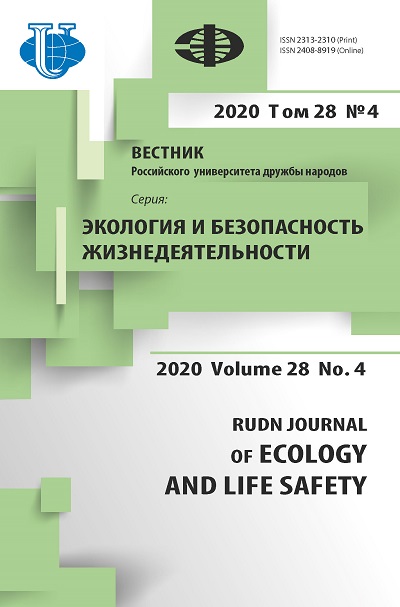Biotesting of cultivation zoocompost of Hermetia illucens larvae
- Authors: Goncharova E.N.1, Kurzenev I.R.1, Vasilenko M.I.1, Pendyurin E.A.1
-
Affiliations:
- Belgorod State Technological University named after V.G. Shoukhov
- Issue: Vol 28, No 4 (2020)
- Pages: 324-335
- Section: Ecology
- URL: https://journals.rudn.ru/ecology/article/view/27347
- DOI: https://doi.org/10.22363/2313-2310-2020-28-4-324-335
Cite item
Full Text
Abstract
A by-product of protein production from the larvae of the black soldier fly ( Hermetia illucens ) is a zoocompost consisting of a variety of organic compounds. The purpose of the work was to determine the hazard class of the zoo complex - the waste of cultivation of Hermetia illucens larvae using biotesting methods, since the use of calculated methods to determine the hazard class is difficult. Biotesting experiments were carried out on test organisms: planktonic crustacean Daphnia magna , algae Chlorella vulgaris , seeds of Avena sativa , Triticum vulgare and Hordeum sativum . It has been established that the zoocompost refers to low-risk waste. Extractions of the zoocompost stimulate the growth of plants Avena sativa and Hordeum sativum , it is supposed to be used as a phytostimulator. It has been shown that an environmentally friendly wasteless method for the production of protein additive from insects is possible.
About the authors
Elena N. Goncharova
Belgorod State Technological University named after V.G. Shoukhov
Author for correspondence.
Email: eleng59@rambler.ru
ORCID iD: 0000-0003-2442-1742
Candidate of Biological Sciences, Associate Professor, Department of Industrial Ecology
46 Kostyukova St, Belgorod, 308012, Russian FederationIvan R. Kurzenev
Belgorod State Technological University named after V.G. Shoukhov
Email: spandwaryandex@gmail.com
ORCID iD: 0000-0002-2975-8152
master student, Department of Industrial Ecology
46 Kostyukova St, Belgorod, 308012, Russian FederationMarina I. Vasilenko
Belgorod State Technological University named after V.G. Shoukhov
Email: vasilemn@mail.ru
ORCID iD: 0000-0001-8203-8325
Candidate of Biological Sciences, Associate Professor, Department of Industrial Ecology
46 Kostyukova St, Belgorod, 308012, Russian FederationEvgeniy A. Pendyurin
Belgorod State Technological University named after V.G. Shoukhov
Email: pendyrinea@yandex.ru
ORCID iD: 0000-0003-4826-3654
Candidate of Agricultural Sciences, Associate Professor, Department of Industrial Ecology
46 Kostyukova St, Belgorod, 308012, Russian FederationReferences
- Federal Law “On Production and Consumption Waste” dated 24.06.1998 No. 89-FZ (latest edition). (In Russ.) Available from: http://www.consultant.ru/document/cons_ doc_LAW_19109/ (accessed: 26.06.2020).
- Tarasova NP, Zajcev VA, Kuznecov VA. Waste-free, clean and green technologies. Advances in Chemistry and Chemical Technology. 2014;28(4(153)):19–22. (In Russ.)
- Kuhar VP, Zajcev ID, Suhorukov GA. Ecotechnology. Optimization of production technology and environmental management. Kiev: Naukova Dumka Publ.; 1989. (In Russ.)
- Laskorin BN, Gromov BV, Cygankov AP, et al. Problems of development of waste-free production. Moscow: Strojizdat Publ.; 1981. (In Russ.)
- Ushakova NA, Nekrasov RV, Pravdin VG, et al. A new generation of probiotic preparations for feed purposes. Scientific Reviews. 2012;(1):184–192. (In Russ.)
- Nekrasov RV, Chabaev MG, Zelenchenkova AA, et al. Nutritional properties of the larvae of Hermetia illucens L. – a new feed product for young pigs. Agricultural Biology. 2019;54(2):316–325. (In Russ.)
- FAO: Insects are an excellent source of proteins and vitamins. Prodmag. 2013. (In Russ.) Available from: http://prodmagazin.ru/2013/05/13/fao-nasekomyie-otlichnyiy-istochnik-belkov-i-vitaminov/ (accessed: 26.06.2020).
- Melekhova OP, Sarapulceva EI. (eds.) Biological control of the environment: bioindication and biotesting. Moscow: Akademiya Publ.; 2008. (In Russ.)
- Order of the Ministry of Natural Resources of the Russian Federation dated 04.12.2014 No. 536 “On approval of the criteria for classifying waste to I–V hazard classes according to the degree of negative impact on the environment”. Moscow; 2014. (In Russ.)
- FR.1.39.2007.03222. Methods for determining the toxicity of water and water extracts from soils, sewage sludge, waste by mortality and changes in fertility of daphnia. Moscow: Akvaros Publ.; 2007. (In Russ.)
- FR.1.39.2007.03223. Methods for determining the toxicity of waters, water extracts from soils, sewage sludge and waste by changing the level of chlorophyll fluorescence and the number of algal cells. Moscow: Akvaros Publ.; 2007. (In Russ.)
















